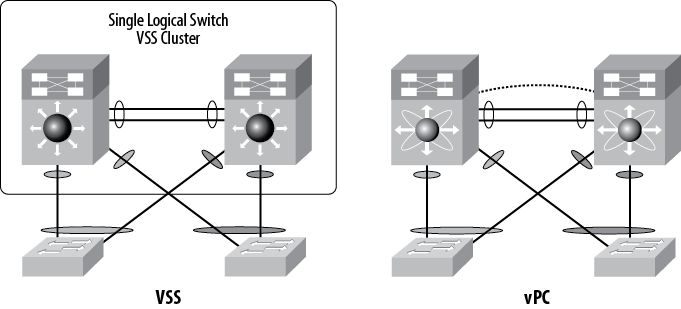Virtual Port Channel
Virtual Port Channel (vPC) is the multichassis port-channel solution for Nexus switches. While the end result is similar, the method used is significantly different than MEC. The main difference has to do with the fact you cannot cluster multiple Nexus switches into a VSS pair the way you can with 6500 VSS switches. Having multiple physical links connecting to two physical switches appear as a single logical link is complicated, and it can take some getting used to when you start to work with the technology. The logical differences are shown in Figure 7-6.

Figure 7-6. VSS MEC versus Nexus vPC
VSS and vPC accomplish the same goal, but in vastly different ways. With VSS, a cluster is configured so that two physical 6500s appear to be a single logical switch (single control plane, single data plane). With Nexus and vPC, the Nexus 5000 or 7000 switches remain separate physical and logical entities (separate control plane, single data plane). The EtherChannel terminates to two separate physical switches on the network side while appearing to be connected to one logical device. If that sounds confusing, thatâs because it is. The good news is that once it clicks, itâs pretty straightforward and easy to configure.
While MEC relies on the VSS cluster to be up and running, vPC requires specific vPC features to be enabled and configured on the Nexus switches. This original ...
Get Network Warrior, 2nd Edition now with the O’Reilly learning platform.
O’Reilly members experience books, live events, courses curated by job role, and more from O’Reilly and nearly 200 top publishers.

